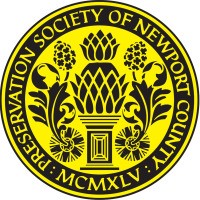Historical note
Hunter House is a Georgian style house from Newport's first "golden age" in the mid-18th century. The house was built and decorated when Newport was one of the largest colonial cities, founded on the principle of religious tolerance that attracted Quakers, Baptists, Congregationalists and Sephardic Jews. The great mercantile families lived patrician lives, often building fashionable harbor-front mansions overlooking their trading ships, and entertained in grand style. These merchants traded raw materials, as well as bought and sold furniture and silver, from local craftsmen such as the Townsend and Goddard families.
Hunter House is a typical example of Georgian domestic architecture, which evolved from its beginnings as a half-timbered, early Colonial structure. Its Georgian incarnation has a symmetrical five-bay façade, with two bays on either side of the central doorway, and chimneys at either end. The gambrel roof was originally covered in wood shingles, typical of the period, but replaced by a slate roof in the 1870s. The exterior of the house is covered in pine clapboards, which were widely available at the time. The use of hardwoods, such as oak, was typically reserved for shipbuilding. The focal point of a Georgian exterior was the front door. At Hunter House, the paneled front door is framed by pilasters that support an elaborately carved broken-arch pediment. At the center of the pediment is a pineapple, the colonial symbol of hospitality and was originally over the waterfront entrance of the structure. The well-known pineapple was moved to the street side of the building after the renovation of the property in 1945.
Hunter House was designed and renovated over a number of years. The north half of Hunter House was constructed between 1748 and 1754 by Jonathon Nichols, Jr., a prosperous merchant and colonial deputy. After his death in 1756, the property was sold to Colonel Joseph Wanton, Jr., who was also a deputy governor of the colony and a merchant. He enlarged the house by expanding the house southward, and adding a second chimney, transforming the building into a formal Georgian mansion with a large central hall. Colonel Wanton also ordered the graining, or "spreckling," of the pine paneling in several rooms to resemble walnut and rosewood. During the American Revolution, Colonel Wanton fled from Newport due to his Loyalist sympathies. His house was used as the headquarters of Admiral de Ternay, commander of the French fleet, when French forces occupied Newport from 1780 to 1781. After the war, the house lay vacant for several years until it was sold by the state in 1786 to a series of short term tenants and owners. During this time, the outbuildings wharf, and warehouses began to deteriorate. Eventually William Hunter, a U. S. Senator and President Andrew Jackson's charge d'affaires to Brazil, purchased the house. The Hunters sold the house in 1863 to the Bay State Steamboat Company, which became the Old Colony Steamboat Company, who then sold it to John P. Gray and Samuel Oakley Vanderpool of New York City. During this time, many changes were made to the property by its tenants, through the installation of modern heating and lighting. Before Dr. Horatio Robinson Storer became its owner in 1881, dubbing the house "Shore Haven”, features were thrown out such as the small caned glass windows and many Scriptural tiles.
Concerned that the fine interiors of the house would be purchased and removed from the building, a small group of dedicated citizens led by Mrs. George Henry Warren initiated a preservation effort, purchasing the house in 1945 and forming The Preservation Society of Newport County. The Preservation Society restored Hunter House to the era of Colonel Wanton. The interior collections include furniture by the Townsend-Goddard family, premier cabinetmakers of the colonial era who worked in the neighborhood of Hunter House. Newport pewter and paintings by Cosmo Alexander, Gilbert Stuart and Samuel King are also on display. Hunter House is a National Historic Landmark.


